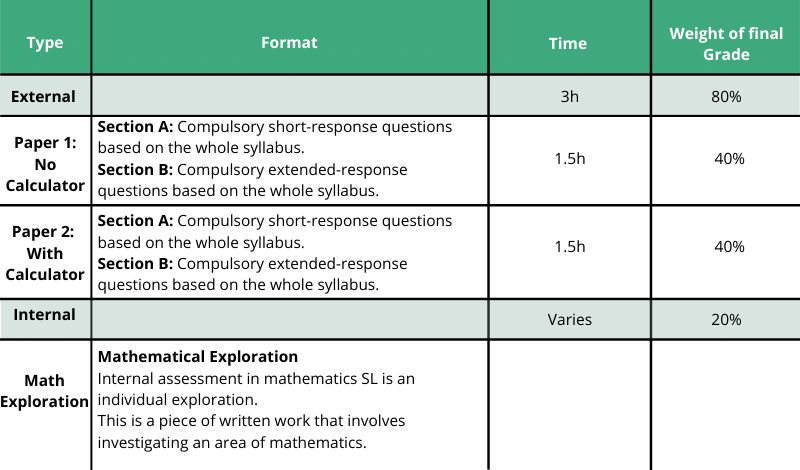IB Math Analysis & Approaches SL Internal Assessment Guide
What is the Internal Assessment?
The Internal Assessment contributes to 20% of your final IB Math AA SL score. It’s a 12-24 page exploration conducted by the student about a certain mathematical topic that is covered by the Math AA SL syllabus.

Find-A-Question
Before you can start writing you need to choose a topic. This Question/Topic will accompany you for the next 2-4 weeks.
Your question should:
- Have (some) personal engagement
- Can be explored mathematically
- Should be able to cover 12-24 pages
- Be (somewhat) unique
- Be meaningful/useful
- Be feasible
“You will succeed because most people are lazy”
Once you have selected your topic make sure that there exists some information that you can refer to. Preferably papers that have already been written. We advise every student to do at least two hours of research before starting their exploration – it will pay off in the end.
Research and Organization

We advise you to bookmark everything you read about your paper as even though it may not seem important, it might be very important in the later stages of your internal.
Once you have found a good topic and did the preliminary research you can start writing your outline. Include the necessary heading included below and then add the headings that are important for your paper specifically. Write a sentence or two about what you want to achieve in a specific section.
Structure
The Structure for every individual internal is different (and also should be different), however, most internal assessments follow roughly the following structure:
Introduction
~ 5-10% of Internal
In the introduction of your math internal you should include the following information:
- Your aim
- The general idea of the exploration
- In what ways you use mathematical concepts to explore your topic
- Your Hypothesis (if applicable)
- A useful diagram/overview
- Define all variables/assumptions/and similar
Assume that a five-year-old is reading and grading your paper. Your introduction must be clearly understandable to everyone.
“An introduction can make or break a paper”
Observation
~ 5-15% of Internal

This is the part of the paper in which you explain your strategy of collecting data in detail. Try to include some personal engagement and evaluation in this part of your internal.
Organize your data coherently.
This is the point of your paper in which you can display all your skills of graphing, making diagrams, tables, etc. Use mathematical tools deliberately to organize your data.
Analysis
~ 50-70% of Internal

The Analysis part of your Internal is the most important part of your internal. Unfortunately, it is also the most difficult part to describe in a guide.
In this section, you are supposed to represent your thoughts, ideas, and most importantly, your ways to get to the solution. Writing in math can be very difficult. This guide makes it a little bit easier, however, it is still a challenge to express yourself mathematically. We advise you to write your math on a piece of paper before you insert it into your internal.
Remember that ALL your answers and ways of achieving these answers must be correct and understandable. You need to SHOW and TELL the reader what you are doing.
Interpretation
~ 5-15% of Internal

The interpretation part of your paper is the part in which you can get many points for Criterion C and D. It also shows that you have a deep understanding of the topic and thus can dive deeper into the subject. Now is the time to show your knowledge. Go all in. Be as detailed as you can. All relevant information that you weren’t able to incorporate into other sections of the paper can now be displayed. This is where you state your ‘general statement’.
Validity
~ 5-15% of Internal
In this section, your job is to connect what you said in your interpretation with what the data actually says. This is the part in which you prove your general statement and everything else you have said in your interpretation part. (You can also change your general statement if the data says something else –> NEED to explain the change). This section is great for mathematical notation and reflection.
Conclusion
~ 5-10% of Internal
All your hard work is now being summarized, reflected on, and evaluated. The Conclusion is used to talk about at least 3 limitations and the scope of your exploration. This is the place in which you write about what you have learned and other possible related extension problems/questions that arose while doing your paper.
Reviewing your internal
Reviewing your paper will be one of the most rewarding and difficult challenges in this process. However, this step will give your paper the last polishing that it needs to become an amazing paper. Tips for reviewing include:
1) Read the paper as if you don’t know it. This way you will eliminate sections that are difficult to understand
2) Check ALL your math
3) Make sure you don’t have unnecessary sentences/pictures, etc. (The IB hates unnecessary information)
4) Check the flow of the paper (A nicely-written paper will always be more enjoyable than something you have cranked out at 11 PM the night it was due – distinguish yourself).
Subscribe to the Inertia Newsletter
IB News, Covid-19 Updates, Deadlines, Tips and Tricks, and Hundreds of Free Resources are Awaiting You!
Features
- Study Notes
- Thousands of IB Questions
- Detailed Answers
- Ask-A-Question System

